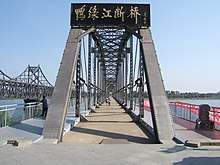Yalu River Broken Bridge
| Yalu River Broken Bridge 鸭绿江断桥 | |
|---|---|
|
The former swing span at the south end of the bridge's surviving portion | |
| Coordinates | 40°06′54″N 124°23′29″E / 40.1149°N 124.3915°ECoordinates: 40°06′54″N 124°23′29″E / 40.1149°N 124.3915°E |
| Crosses | Yalu River |
| Locale | Dandong, Liaoning, China |
| Characteristics | |
| Material | Steel |
| Total length | Originally 944.2 m (3,098 ft) |
| Width | 11 m (36 ft) |
| History | |
| Opened | October 1911 |
| Closed | 1950–1951 |
The Yalu River Broken Bridge (simplified Chinese: 鸭绿江断桥; traditional Chinese: 鴨綠江斷橋; pinyin: Yālù Jiāng Duàn Qiáo) is a half-destroyed railway bridge over the Yalu River that connected the Chinese city of Dandong with the North Korean city of Sinuiju. It was the first bridge across the Yalu, built by the Empire of Japan in 1911 to connect Korea (then under Japanese rule) to the Eurasian rail network. Its Korean half was destroyed by American bombing during the Korean War, and has been dismantled. Four spans (out of an original 12) on the Chinese side of the bridge remain standing and are preserved as a historical and tourist site.
Location and dimension
The railway bridge is located in Dandong, Liaoning, China, across the Yalu River from Sinuiji, North Korea. It was a steel truss bridge 944.2 metres (3,098 ft) long and 11 metres (36 ft) wide, with 12 spans. Its fourth span was a swing bridge that could be rotated to allow the passing of tall ships.[1]
History

The bridge was built by the Empire of Japan in 1911, to connect Japanese-ruled Korea with the Eurasian rail network. With its completion, the southern Korean port of Busan became connected by rail all the way to Calais, France.[2] The Japanese began building the bridge in 1909, before the Qing dynasty government of China granted permission for its construction. By April 1910, with the Korean side of the bridge already half completed, Japan applied heavy pressure on the weak Qing government, then in its last throes, to authorize construction on the Chinese side. It was opened in October 1911, the first bridge across the Yalu River.[1] In April 1937, when Northeast China was ruled by the Japanese puppet state Manchukuo, Japan built a bigger bridge less than 100 metres (330 ft) upstream, now known as the Sino-Korean Friendship Bridge.[1]
During the Korean War, the United States Air Force repeatedly bombed the Yalu River bridges to disrupt the transportation of Chinese troops and supplies into North Korea. On November 8, 1950, the US dispatched more than 100 B-29s to bomb the bridges, and six days later, another 34 bombers attacked and destroyed three spans of the older bridge.[1] The aerial attacks were suspended on December 5 because the Yalu was frozen over and the Chinese could easily cross the river at many points.[3] In February 1951, the US resumed bombing and destroyed the bridge except four spans on the Chinese side. From then on it became known as the Broken Bridge.[1]
Heritage and tourism


After the end of the Korean War, North Korea dismantled its side of the severely damaged bridge. Four spans on the Chinese side, pockmarked by shrapnel, were left in place and preserved. In 1988, the City of Dandong declared Broken Bridge a municipal heritage site.[4]
In 1993, the local government invested 3 million yuan to refurbish the bridge and opened it as a tourist attraction.[4] Visitors can walk on the bridge to the middle of the Yalu River. The end of the Broken Bridge has become a viewing platform for visitors to get a closer look at North Korea.[2]
The Broken Bridge is now a Major National Historical and Cultural Site of China.[1]
See also
- New Yalu River Bridge - a new Chinese-built crossing that has been left incomplete because North Korea has not built any roads connecting to its end of the bridge.
References
- 1 2 3 4 5 6 Zhao, Na (2011-09-06). "鸭绿江断桥:沧桑历史的见证者". China.com.cn (in Chinese). Retrieved 2018-02-10.
- 1 2 Morris-Suzuki, Tessa (15 November 2010). To the Diamond Mountains: A Hundred-Year Journey through China and Korea. Rowman & Littlefield Publishers. pp. 75–76. ISBN 978-1-4422-0505-5.
- ↑ United States Army in the Korean War. United States Government Printing Office. 1961. p. 246. ISBN 978-0-16-088234-0.
- 1 2 "鸭绿江端桥将恢复"断桥"名称". People's Daily (in Chinese). 2000-06-12. Retrieved 2018-02-11.
External links
